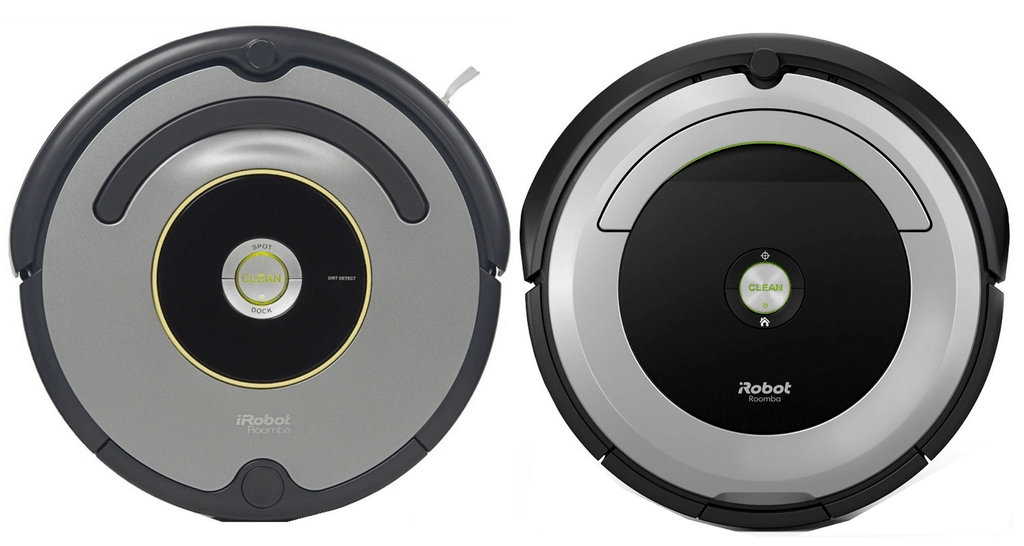20 years ago the Roomba 600 series debuted and they were considered the best robot vacuums ever created. Fast forward to today, in 2020, and the 600 series robots are still being sold in record numbers. What they lack in features and technology, they make up for in durability and efficiency.
The Roomba 690 is the top of the 600 series food chain, but some later models have sprung up to attempt to outsell the best of the series. The Roomba 670, for example, has a lot of the same things to offer. Which one is better for you? In short, the Roomba 690 is still the better buy. Read on to find out why.
Contents
Differences between Roomba 670 and 690
[easyazon_image align=”none” height=”500″ identifier=”B07JD8PVT3″ locale=”US” src=”https://smartrobotichome.com/wp-content/uploads/2020/04/41AitpSOBjL-1.jpg” tag=”srh-easyazon-20″ width=”500″]
[easyazon_image align=”none” height=”500″ identifier=”B06XRT2B3P” locale=”US” src=”https://smartrobotichome.com/wp-content/uploads/2020/04/41TRoGy5I7L.jpg” tag=”srh-easyazon-20″ width=”500″]
There aren’t a lot of differences to be honest. The Roomba 670 is the 690, only it was released in Australia first. Technically it is the 675 model, but the similarities are minuscule. There are a few differences, though. Let’s have a look.
- The Roomba 690 comes with a dual-mode virtual wall barrier. While the 670 is compatible, it doesn’t ship with one.
- The Roomba 690 is more readily available in the US than the 670 model is.
- The Roomba 690 is black on black while the 670 is silver on black. There is a black model of the 670 which is sold in AU and Europe, though it can be found in the US now.
Similarities between Roomba 670 and 690
All other features between the two models are the same, so I won’t bore you with an exhaustive list here. However, I do want to point out the more important features they have in common.
- Battery runtime. Both the 690 and 670 have the same potential 90 minute runtime.
- Automatic recharge. The two robots will monitor their battery charge and return to the Home Base when they get low.
- Wireless communications. Each model is WiFi to allow for voice and mobile app controls.
- You can create, edit and delete scheduled cleaning sessions at any time.
- Floor types. The Roomba 670 and 690 are rated to clean all floor types.
- Dust bin capacity. You will find a moderate 0.5L collection bin in both models.
- The two robots each come with iRobot’s 1-year full warranty.
Comparison Table
Here we can see the two robots side by side in order to see what features and options they offer you.
| Roomba 670 | Roomba 690 | |
| Size | 13.3×13.3×3.6 inches | 13.3×13.3×3.6 inches |
| Weight | 7.8 pounds | 7.8 pounds |
| Navigation | IAdapt 1.0 | iAdapt 1.0 |
| Color | Silver on Black | Black on Black |
| Battery | 1800mAh lithium-ion | 1800mAh lithium-ion |
| Runtime | Up to 90 minutes | Up to 90 minutes |
| Charge Time | 3 hours | 3 hours |
| Automatic Recharge | Yes | Yes |
| Entire Level Clean | No | No |
| Filter | AeroVac Standard | AeroVac Standard |
| Drop Sensors | Yes | Yes |
| Bump Sensors | Yes | Yes |
| Dirt Detection Sensors | Yes | Yes |
| Camera Navigation | No | No |
| Wireless Communications | Yes | Yes |
| Mobile App | Yes | Yes |
| Voice Controls | Yes | Yes |
| Floor Types | All | All |
| Collection Bin Capacity | 0.5L | 0.5L |
| Side Brushes | 1 Side Brush | 1 Side Brush |
| Containment | None included | 1 Dual Mode Virtual Wall Barrier |
| Warranty | 1 year | 1 year |
| Price | Check on Amazon | Check on Amazon |
Comparing the Roomba 670 to the 690 in Detail
I could tell you about each feature and compare them between the 670 and 690, which is normally what I do in this section. However, with the exception of the containment area below, each round would be a tie.
Instead, for this Roomba 670 vs. 690 review and comparison, I will explain the features and how the two robots use them. This will help you understand the aspects of the machines to see if they meet your needs.
Operational Basics For Both Models
The batteries in the robots are the 1800mAh cells that offer up to 90 minutes of power. This, of course, depends a lot on your homes layout, number of obstacles and type of flooring. The more open space and hard flooring you have, the closer to 90 minutes you will get.
Once the battery charge level drops to about 10 percent, the robots will start making their way back to the Home Base charging station for a recharge. However, since neither robot maps your home, they will stay on the charger until the next scheduled cleaning time.
The Filters Work but That’s About it
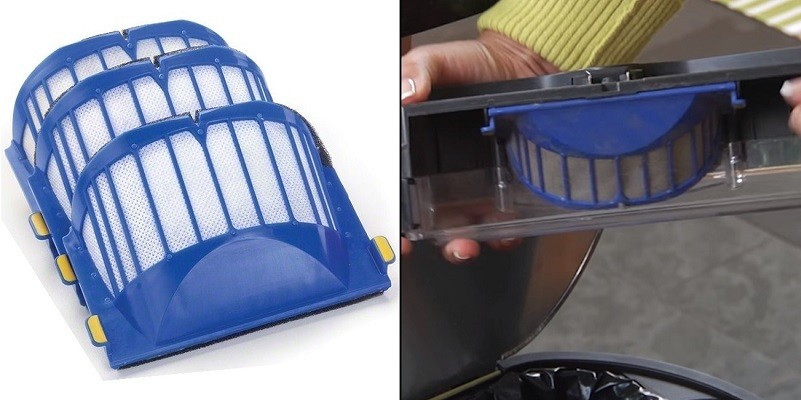
The filtration isn’t the best in either model. While the AeroVac system does its job, the filters don’t go above and beyond. The standard filters will capture particles to 10 microns, but this is by no means a HEPA filter (3 microns) and it will not lower the amount of in-home allergens.
You will also need to replace the filter about every 4 to 6 months. Luckily for you, both the 690 and 670 come with a filter installed and a spare filter in the box, so you shouldn’t have to worry about a filter purchase for the first year.
You will also notice that the first few times you run the robots around they will fill the collection bins pretty fast. You have a lot of dirt and debris in your floors that you aren’t aware of and these little guys will get a lot of the gunk out of your floors.
Cleaning out the collection bins is simple and only takes a few seconds, but you will need to do this after every cleaning cycle for the first couple of weeks. As the robot cleans more and more, this can be done after every second or even every third cleaning session.
Navigation is Simple, to put it Mildly
Lastly, the iAdapt navigation is the other basic feature that they share. The robots don’t have cameras or lasers or GPS cubes to know where they are in your home. They rely on touch and drop sensors to know where they can and cannot go.
The sensors work well, though you will notice that the machines bang into everything. They don’t cause any harm to your surfaces, but end tables or lighter and top-heavy furniture pieces may wobble some.
These robots won’t go where they can’t access and they won’t drop off the top of your staircase, either. You may have some issue with black flooring as this absorbs the infrared light which tells the robot it is a cliff or ledge. Unfortunately, there isn’t much you can do about this, though some users find placing tape over the sensors will work.
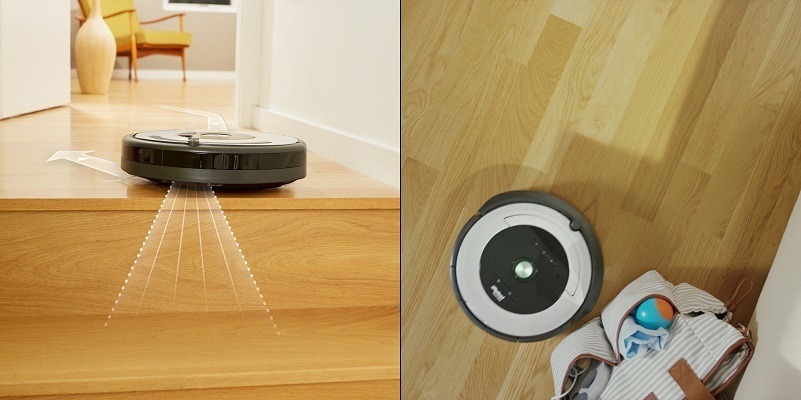
Just make sure if you do this “hack,” that you don’t put the robot on a second story or where it can fall, because it won’t be able to sense the drop-off.
3-Stage Cleaning and Performance
The cleaning system used by the 600 series is known as AeroVac, don’t worry about specs, it’s just the name iRobot uses for their 3-stage cleaning set up. The three stages are extraction, collection and filtration.
We already covered the collection and filtration so let’s focus on the extraction. On each of the robots you will find two extractors. The smaller one up front is a rubber bladed roller that works somewhat to agitate the carpet (thought, honestly, it only gets the topmost layer) and to help keep the other roller clean.
The “other roller” is the primary roller. It uses soft bristles to loosen and lift dirt and debris for collection. Because it is made of bristles, it will wear down and need to be replaced. It will also collect a lot of hair, fur and string, which will need to be cleaned off.
Both robots come with a cleaning tool to help in the maintenance, but it is still a pain. The rollers work well, though, for what they are. I will discuss in more detail below how well these robots clean specific floor types.
Once the debris is collected by the roller, it is pushed into the collection chamber by the suction created by the motor, where the debris is deposited into the collection bin and the air is filtered and exhausted out the rear of the machines.
Control Options for the Roomba 670 and 690

The Roomba 670 and 690 have three control options. You will get local controls which are push buttons to accomplish three different tasks. First is the clean button that sends the robot off to do a whole house cleaning session.
You can also choose the spot clean function which will detail a small area about 3-feet in diameter. Finally, you can send the robot to the charging station by pressing the home button.
The other control methods require a wireless network in your home. The first is voice commands that work through Amazon Alexa or Google Assistant enabled devices. You can perform basic cleaning functions with your voice by having your assistant tell the robot to clean, pause or resume or head to the Home Base and end a cleaning session.
Finally, you have the iRobot Home mobile app. This will be the primary control option, should you elect to use it. You can take full control of the robot, perform all cleaning modes and features, and you will also get some reports on battery usage, when to change the filter and cleaning times.
Containment is the Difference
The one true difference between the robots is the containment options. Both robots use the dual-mode virtual wall barriers. These are battery operated towers that emit an infrared beam the robots will not cross.
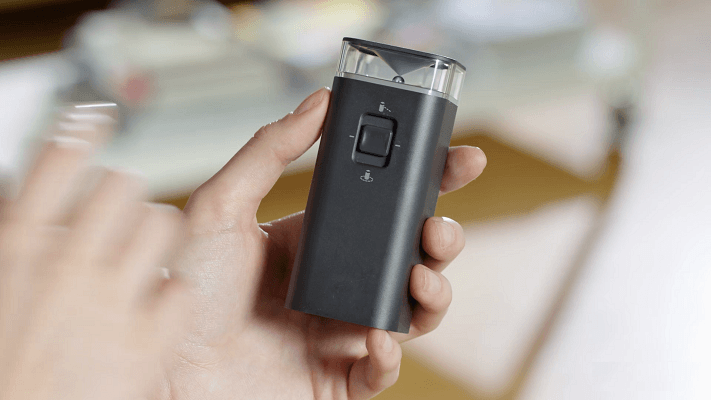
You can set them up in linear mode across doorways, entrances and exits, or using the full 10-foot light length, to split rooms into sections. You can also set them to halo mode which produces a ring of infrared that extends about 4-feet. This is useful for protecting your top-heavy furniture pieces, plants, lamps and your pets water bowl.
The difference in the two models, is that by default, the Roomba 690 ships with a barrier in the box while the 670 requires you to purchase them separately.
Amazon will usually have a bundle deal, if you shop through them, where you can get the robot and 1, 2 or more barriers. However, if you purchase the same bundles, the 690 will always have one more because of the included one.
Real-World Cleaning Tests
In the videos you will find on line, or in the commercials, it is easy for the robots to look almost too good to be true. But what really happens when you get them home? That’s what matters the most, right?
iRobot can legally claim the 670 and 690 can run for 90 minutes, because they can prove it. As long as there is no furniture, all hardwood floors and a vast empty space to run in. I don’t think you live in a vast open space without any furniture, a throw rug or anything on your floors. If you do, maybe a robot vacuum shouldn’t be your primary purchase concern at the moment.
However, I feel it is important to let you know what to expect when you get these bad boys home and let them loose on your floors. So, I am going to tell you.
On Carpet
The Roomba 690 and 670 do a fairly decent job on most carpeting. If you have high-pile or shag, you are better off with the Roomba 900 series, like the 980. The bristles on the rollers of the 600 series just doesn’t work on high-pile.
However, low and medium pile carpeting will be cleaned pretty well, considering. There isn’t much agitation, so don’t be disappointed when there is still dirt and gunk in the bottom fibers of your carpet. Your upright vacuum should be able to handle this.
For day to day maintenance of the top layer of your carpeting, though, the 690 and 670 are worthy.
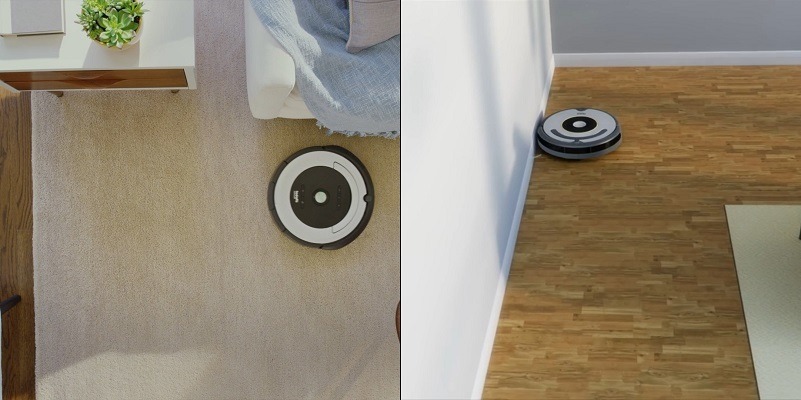
On Hard Flooring
Hard flooring will be much easier to clean for all robots, including the 670 and 690 models. The rollers will easily sweep the debris from the floor and the suction power doesn’t matter as much since there isn’t anything like carpet weave to get in the way.
That being said, you will find that neither robot does that great along the edges or deep into corners. The easiest solution is to grab your broom and sweep the corners and edges out in to the middle of the floor before the robots get to that room. It’s an extra step, but the results will be much better.
Dealing with Pet Hair
Both robots are marketed for those with shedding pets. Yes, the rollers will extract the pet hair, and yes, you will find huge piles stuffed into the collection bins.
But, what you don’t see anywhere else is the time and maintenance it takes to keep the brush rollers clean. Until the robots are able to overcome the amount of hair and keep on top of it (about 2 or 3 weeks worth of daily cleanings), you will need to consistently clean off the bristles of the roller.
In the very beginning, you may find that you have to stop a cleaning session to unclog the rollers. After the first few times, though, you can wait until after the cleaning is completed.
Frequently Asked Questions
Now I will answer a few of the more commonly asked questions that people also ask about the Roomba 670 and 690 models, or about iRobot in general. If you have other questions, please feel free to use the comment section below.
Q. Do cats prefer to ride on the Roomba 670 or 690?
A. Actually, neither. Since it’s release the feline community at large will only accept transportation by the Roomba s9+. If you have a cat that needs a robotic lift, you definitely need to purchase the s9+ model.
Q. How do I make a warranty claim on the Roomba 670 or 690?
A. As long as you bought the robot new-in-box you get a 1-year warranty (90 days for refurbished models). You can call iRobot at 1-800-727-9077 to start the claims process. They will walk you through trouble shooting and verify that the robot is defective and once verified, go from there.
Q. Do I need to buy anything extra for the Roomba 690 or 670 models?
A. To get started with, no. Everything you need to start cleaning your floors is included in the box. However, you will eventually need new filters, a new side brush and even a new brush roller. Refill kits are available. You can also purchase replacement batteries, wheels and other parts, as needed, through iRobot’s shop or Amazon.
Q. Where is the best place to purchase a Roomba 670 or Roomba 690?
A. Currently, the best place is through Amazon. They have a larger stock and can ship faster than other online retailers, including iRobot. You also get proper proof of purchase, dates and receipt retention should you need to make a claim in the future. Amazon will also often have the lowest prices available on these older models, where even iRobot still charges full retail prices.
What I Like About the Roomba 670
- Decent cleaning on all floor types.
- Takes on pet hair without too much fuss.
- Runs long enough to cover most medium-sized homes.
What I Like About the Roomba 690
- Includes a containment barrier with purchase.
- Will cover about 1100 square feet on a single charge.
- Returns to the charging station on its own.
Conclusion
The only difference between the two robots is that the 690 is a different color, can be found for sale in more retail locations and comes with a dual-mode virtual wall barrier.
So which one should you get? The answer lies in your containment needs and budget. In general, the 670 will be cheaper. However, you will need to buy the virtual walls separately. If you can live without them, or need to save a few extra dollars, the 670 is your choice.
On the other hand, if you want more included with your purchase and don’t want to scrounge for the right model, the 690 is still the better option. The included containment and better availability can lead to a lower price overall, making it a better deal in the long run.
